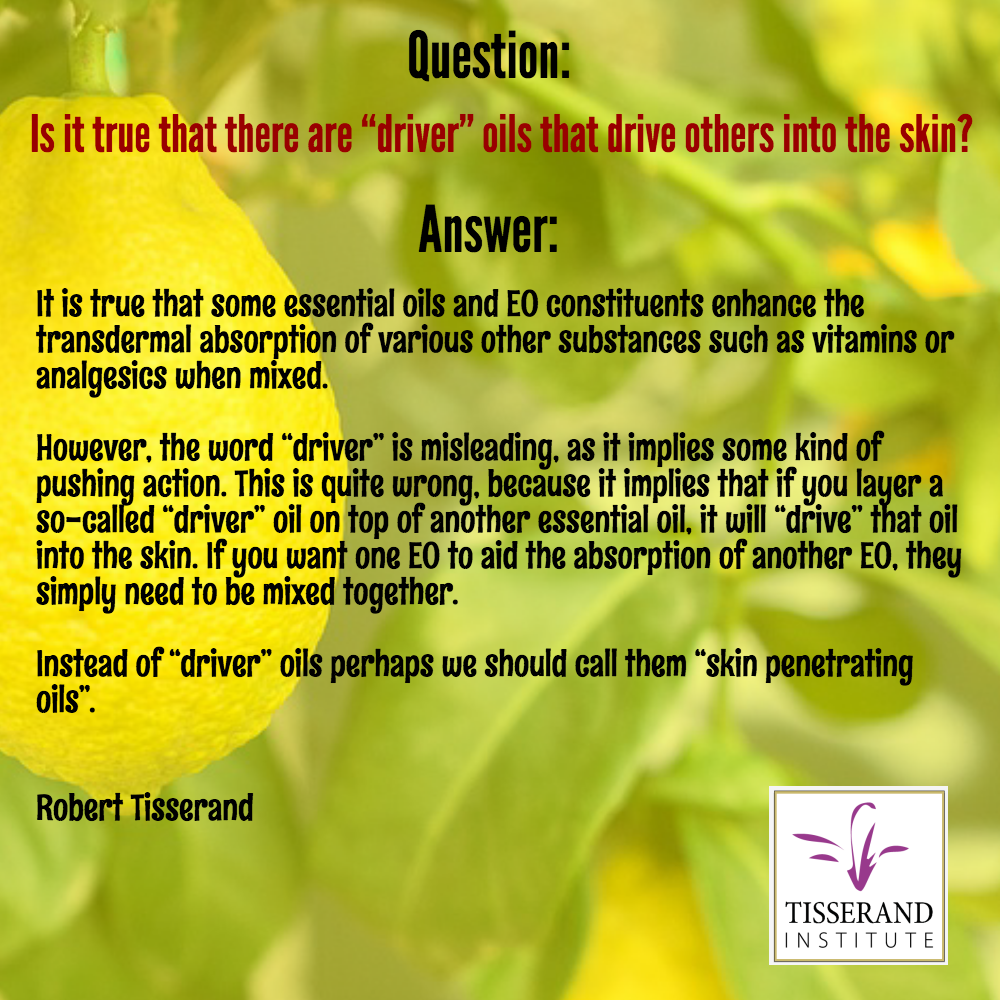Q&A Tuesday!
Question: Is it true that there are “driver” oils that drive others into the skin?
Answer: It is true that some essential oils and EO constituents enhance the transdermal absorption of various other substances such as vitamins or analgesics when mixed. There’s masses of research, here is a small sample:
https://www.ncbi.nlm.nih.gov/pubmed/22515469
https://www.ncbi.nlm.nih.gov/pubmed/26319631
https://www.ncbi.nlm.nih.gov/pubmed/25557808
https://www.ncbi.nlm.nih.gov/pubmed/25853969
https://www.ncbi.nlm.nih.gov/pubmed/23311649
“Transdermal absorption” means that the substance passes through the skin and into the bloodstream, or at least some of it does. Most substances, especially those that are water-soluble, are not able to penetrate the skin.
However, the word “driver” is misleading, as it implies some kind of pushing action. This is quite wrong, because it suggests that if you layer a so-called “driver” oil on top of another essential oil, it will “drive” that oil into the skin.
If you want one EO to aid the absorption of another EO, they simply need to be mixed together. Whether the mixing happens before or after application to the skin doesn’t make a whole lot of difference – both need to contact the skin equally, at the same time.
Instead of “driver” oils perhaps we should call them “skin penetrating oils”. Suggestions?
There is little research on essential oils aiding transdermal absorption of other essential oils. But in general, essential oils high in light, more volatile constituents are most likely to have this effect. These include Eucalyptus, Citrus, Frankincense, Rosemary, Peppermint, Pine and Spruce oils. These are likely to aid transdermal absorption of “heavy” oils like Copaiba, Sandalwood, Patchouli, Vetiver etc. This is an over-simplification of the reality, but it’s basically true. (And no, Copaiba oil is not a skin penetration enhancer.)
Incidentally, “carrier” oils do not aid transdermal absorption of essential oils. They mostly consist of triglycerides, which are very large molecules. However, essential oils may well aid the absorption of single fatty acids in vegetable oils.


Three studies suggest that copaiba oil is a permeation enhancer.
Quiñones OG, Hossy BH, Padua TA, et al. Copaiba oil enhances in vitro/in vivo cutaneous permeability and in vivo anti-inflammatory effect of celecoxib. J Pharm Pharmacol. 2018 Jul;70(7):964-975.
Quinones OG, Abranches RP, Nakamura MJ, et al. Copaiba Oil: Chemical Composition and Influence on In-vitro Cutaneous Permeability of Celecoxib. Curr Drug Deliv. 2018;15(3):357-366.
https://pdfs.semanticscholar.org/bbd2/65b4ed868ebc25b6e9277eb204f2ff6139db.pdf
It’s possible that Tea tree oil is also a driver oil. The ‘oil’ is actually a skin dryer, it reduces oils in the skin, by removing those oil barriers, the ‘driver’ would actually allow other topical oils to be absorbed a little better. That’s because the natural oils in the pores of the skin are reduced, it may also mean that other astringents could enhance topical absorption.
All highly volatile essential oils (i.e. most of them) have a drying effect on the skin if used undiluted, and this could very well disturb the skin’s barrier function, leading to increased absorption. But, research shows that most of the constituents of Tea Tree oil are not very well absorbed by human skin. I’m not aware of any research showing that removing surface lipids from the skin leads to increased absorption.